Meeting, Saturday 4 September 2004
after action report
The Seven Years War
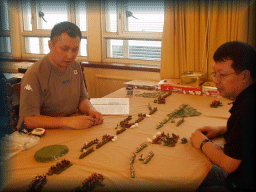 The battlefield was basically a flat plain.
The French right wing was covered by a light wood while the Russian left
wing also benefited from the cover of another light wood. The French
deployed all of its artillery in the centre while the cream of the cavalry
was deployed on the left wing. Two units of infantry were to be
advanced into the wood on the right wing while dragoons covered the
extreme right.
The battlefield was basically a flat plain.
The French right wing was covered by a light wood while the Russian left
wing also benefited from the cover of another light wood. The French
deployed all of its artillery in the centre while the cream of the cavalry
was deployed on the left wing. Two units of infantry were to be
advanced into the wood on the right wing while dragoons covered the
extreme right.
The Russians also deployed their main cavalry force on the right wing in order to deal with the French Cavalry. The infantry were deployed in the centre with artillery support between each regiment. A Hussar regiment and a Jager regiment covered the right. The Russian had superiority in artillery and outnumbered the French both in quantity and calibre.
The battle started with the Russian advancing toward the French position. The French were in a defensive position after occupying the wood on the right wing and awaited the coming onslaught of the Russian artillery fire. The Russians advanced into artillery range and deployed most of the heavy guns in the centre. On the Russian left, the Hussars and the Jagers were supported by a battery of medium guns and slowly drove the French Dragoon back.
 The Russian offensive started by opening
artillery fire on the French infantry. A French Line regiment lost 25% in
just one turn. The Russian cavalry on the right also charged.
The Cuirassiers and the Dragoons of the Russians drove back the French
Dragoons in a single charge and also routed another Hussar unit in the
subsequent breakthrough. Thus, the French left wing was left widely
exposed.
The Russian offensive started by opening
artillery fire on the French infantry. A French Line regiment lost 25% in
just one turn. The Russian cavalry on the right also charged.
The Cuirassiers and the Dragoons of the Russians drove back the French
Dragoons in a single charge and also routed another Hussar unit in the
subsequent breakthrough. Thus, the French left wing was left widely
exposed.
Meanwhile in the centre, the French infantry advanced under the heavy fire of the Russian artillery and were soon reduced to nothing. The Russian Musketeers counterattacked by charging the much damaged French Line.
On the French right the 2 infantry regiments advanced out of cover and drove back the Russians screening the wood. The only French Dragoon left on the field charged the Russian Hussars in order to save the day. The Russian Hussars counter-charged instead of evading and successfully drove the French away.
At that point the French casualties were too heavy and the French had to withdraw. The Russians claimed the victory.
James Cheung
Flames of War (FOW)
We
played 2 FOW games during that meeting, both were "Big Push"
scenarios, one with classic Soviet v Germans, the other Soviet v
Japanese. As it was our first time to play with WWII Japanese, I
would like to share with you the result.
Rules: FOW from Battlefront
Models: 15mm from Peter Pig and Battle Honours (painted by Alex
Lam)
Time: assumed to be 1945
Place: Manchuria
Army list: Japanese army list is unofficial and can be downloaded
from the Yahoo website.
Background:
Historically the Soviets assaulted Manchuria after the atomic bomb was
dropped, the Imperial Japanese Army there, called the "Kwangdong
Army", once the proud and best equipped Japanese field army, was
quickly overrun. This was mainly because their commanders knew
unconditional surrender was under negotiation and in fact most of the
"Kwangdong" army had drained out to other battlefields in
previous years, only a skin covered the framework that remained.
 The defender "Kwangdong" army consisted of 2 infantry platoons
(B-grade as they were not fully mobilized), a 75mm howitzer battery, a
type-97 Tank platoon, a type-95 tank platoon, plus a platoon of Self
Propelled guns. As for the scenario, defenders had to assign half of
their platoon as reserve, but they got lots of fortifications in return.
so the Japanese put all their tanks in reserve. The Japanese lacked
anti-tank weapons, except for those howitzers and those infantry carrying
demo charges.
The defender "Kwangdong" army consisted of 2 infantry platoons
(B-grade as they were not fully mobilized), a 75mm howitzer battery, a
type-97 Tank platoon, a type-95 tank platoon, plus a platoon of Self
Propelled guns. As for the scenario, defenders had to assign half of
their platoon as reserve, but they got lots of fortifications in return.
so the Japanese put all their tanks in reserve. The Japanese lacked
anti-tank weapons, except for those howitzers and those infantry carrying
demo charges.
For the Soviets, it was assumed they were a B-grade division too
(Historically those soviet units that participated in this campaign were
reallocated from Europe after their victory over Germany, so were
definitely crack units.), however for game balancing purposes, we assumed
the Soviet unit in this game was from the Far East Military district and
was mainly recruited from local Mongolians. Both troop quality and
equipment was not first grade. The Soviet attacker consisted of 2 infantry
companies, 2 HMG platoons, 1 anti-tank rifle platoon, plus a company of
T-34s (which would a great headache for the Japanese since they didn't
have any weapons that could penetrate its armour).
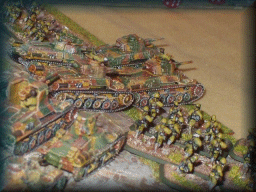 The battle started with Soviet moving fast to the minefield in front of
Japanese defensive positions, it was very dangerous to cross the minefield
without clearance of mines, so the first job for Soviet infantry was to
clear a route through the minefield. Covered by heavy machine gun
firie, those newly conscripted infantry risked their lives in the
minefield. Awakening from the initial bombardment, the Japanese
defenders tried to concentrate all their firepower on those guys who were
lying inside the minefield and therefore heavy casualties were reported
from the Soviet side. The Japanese defenders also received heavy
rain of bullets from the Soviet side, but their well prepared trenches
plus "Bushido" spirit made them carry on.
The battle started with Soviet moving fast to the minefield in front of
Japanese defensive positions, it was very dangerous to cross the minefield
without clearance of mines, so the first job for Soviet infantry was to
clear a route through the minefield. Covered by heavy machine gun
firie, those newly conscripted infantry risked their lives in the
minefield. Awakening from the initial bombardment, the Japanese
defenders tried to concentrate all their firepower on those guys who were
lying inside the minefield and therefore heavy casualties were reported
from the Soviet side. The Japanese defenders also received heavy
rain of bullets from the Soviet side, but their well prepared trenches
plus "Bushido" spirit made them carry on.
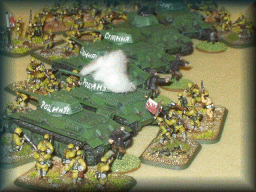 Finally a narrow gap was created in the minefield and 6-7 T-34s quickly
crossed it; they overran those trenches nearby, which left only a battery
of 75mm howizters that could stop the Soviets from reaching their game
objectives. Then Japanese tanks appeared on the flank of T-34s, event
hough their shells couldn't penetrate T-34 side armour, the rapid fire
from these tanks, plus the direct fire from the howizters, finally scared
those conscript tank crews and they foolishly bailed out from their
tanks. Judging it was the golden opportunity to defeat the T-34s,
the Japanese Company commander captain Watanabe drew his sword, shouted
loudly: "For the Emperor, banzai!!" and led the remaining
infantry charge to the abandoned Soviet tanks . . .
Finally a narrow gap was created in the minefield and 6-7 T-34s quickly
crossed it; they overran those trenches nearby, which left only a battery
of 75mm howizters that could stop the Soviets from reaching their game
objectives. Then Japanese tanks appeared on the flank of T-34s, event
hough their shells couldn't penetrate T-34 side armour, the rapid fire
from these tanks, plus the direct fire from the howizters, finally scared
those conscript tank crews and they foolishly bailed out from their
tanks. Judging it was the golden opportunity to defeat the T-34s,
the Japanese Company commander captain Watanabe drew his sword, shouted
loudly: "For the Emperor, banzai!!" and led the remaining
infantry charge to the abandoned Soviet tanks . . .
The Soviet breakthrough was repulsed but captain Watanabe would not return
to his family forever.
Herbert Wong
 |

|
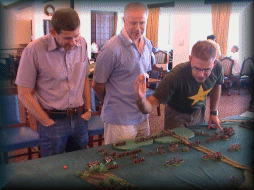
|
|

|
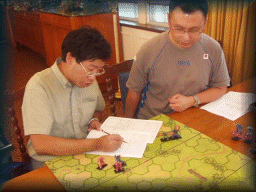 |